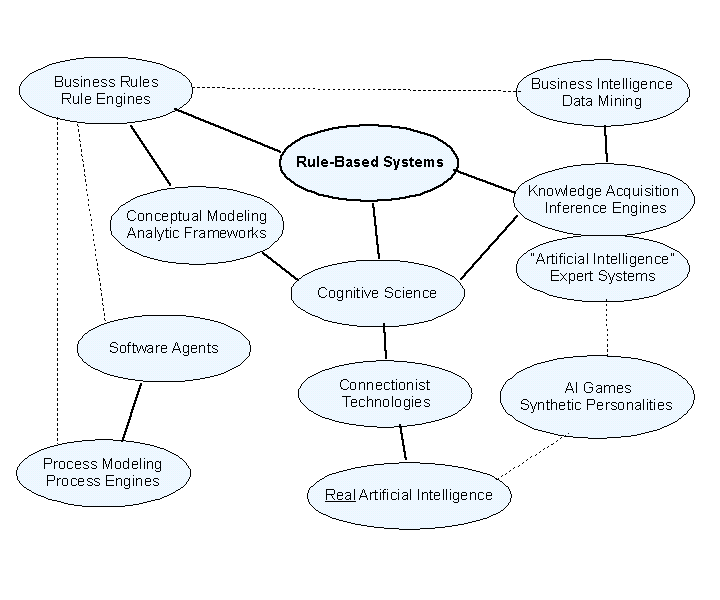Defining Rule Based Systems
Revised: Sept 25,2007
Modeling the Subject of "Rule-Based Systems"
Definitions can be seen assertions about relationship between well-defined terms, in other words things are defined in terms of other things. The terms and relationships associated with "rule-based systems" are ill-defined and make a rigorous definition nearly impossible to achieve.
Nonetheless, it is possible to recognize subject areas that are associated with rule-based systems in a rough-and-ready way, even if the things being associated have no clear boundaries. Think of the following terms as jello and the relationships between them as nails.
The diagram shows a subject model of some basic associations between areas related to rule-based systems - solid lines denote strong associations and dashed lines denote weak associations.

Note that the model is neither complete nor entirely consistent. For instance, the important subject of pattern-matching and case-based inference engines is buried somewhere between Data Mining and Knowledge Acquisition, but it really deserves its own subject entity. In a sense, pattern-matching is more fundamental than rule-based systems, in other words, rule-based systems are a special case of pattern-matching systems. However, even with several deficiencies, the model achieves a certain degree of explanatory power that helps define rule-based systems.
At the center of the diagram is the subject "Rule-Based Systems". The subjects around it are either directly or indirectly associated, either strongly or weakly. The model can be simplified by unrolling it to look like a top-down tree structure, similar to subject hierarchy ( a taxonomy ). In this scheme, a simple one-level hierarchy would be:
- Rule-Based Systems
- Business Rules and Rule Engines
- Cognitive Science
- Knowledge Acquisition and Inference Engines
- "Old Time" Artificial Intelligence and Expert Systems
This is saying that in order to define rule-based systems, four strongly related subjects need to be considered: Business Rules, Cognitive Science, Knowledge Acquisition and Expert Systems. Other weakly or indirectly related subject areas may also be significant. Utilizing a wide spread of subjects may help to capture important nuances in the definition. More specifically, a usable definition of rule-based systems needs to recognize the role of rules in inexact, abductive modes of reasoning - in other words, defining IF/THEN rules as a type of pattern. Usually, the definitions restrict rules to to purely deductive modes of reasoning, which ( I think ) is too constraining for the Semantic Web.
In fact, the subject of "Semantic Web" is missing from the model ( rather spectacularly ) and it looms over the whole effort as a sort of unannounced presence. The Semantic Web "super-subject" connects implicitly to every subject in the model, including "AI Games", whose presence would be inexplicable from a purely business rules perspective.
From a methodological standpoint, it should be noted that the relationships expressed in the model really have no arrows to guide the way in building a subject tree; the lines are simply associations. In the semantics of the model, the subject "Rule-Based Systems" was chosen as the root subject in an arbitrary way, if a very useful way.
For all its deficiencies, the model may be adequate as a first version, it will certainly evolve over the next few months. Hopefully, this effort will lead to a better definition than the usual one, that is "it is when you take working memory, a set of rules and a rule engine and then you ....".
